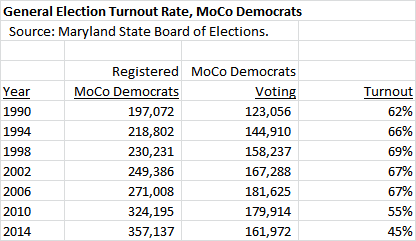By Adam Pagnucco.
December 13 will be an important date for the fortunes of Democrats across the State of Maryland. It’s not because that is the date of a primary election; that won’t happen for another year and a half. It’s not because a critical piece of legislation will be passing; the General Assembly won’t be in session. And it won’t be because Donald Trump will decide that being President isn’t worth it (although one can dream).
December 13 is the day on which the Montgomery County Democratic Central Committee (MCDCC) will select its new officers. And it comes at a critical time for county Democrats, as well as party members all over the state.
When MCDCC is acknowledged by the general public at all, it is usually because of its power under the state’s constitution to fill state legislative vacancies. But the Central Committee does far more than that. Its principal purposes are to build the party, support Democratic candidates and turn out its members to vote. Every four years, the county party raises more than $200,000 for state and local elections and more than $700,000 for federal elections. Major uses of funds include voter registration, production of the party’s sample ballot, coordinated campaigning with Democratic candidates in general elections and overhead associated with the party’s office in Kensington.
MoCo’s Democratic Party has played a fabled role in state politics for many years. It is by far the wealthiest local party organization in the state. It draws on hundreds of precinct officials and other activists for volunteer activities. It has delivered hundreds of thousands of votes to statewide candidates like former Governors William Donald Schaefer, Parris Glendening and Martin O’Malley, none of whom represented MoCo in their prior positions. The party’s influence has been so extensive that statewide Democratic nominees could offset their losses in Western Maryland and the Eastern Shore by racking up votes in MoCo, thereby leaving the Baltimore suburbs as the battle ground in which most races are decided.
But those halcyon days are coming to an end. The MoCo Democratic Party is in trouble, and that means the state Democratic Party is also in trouble. Consider the following.
Turnout of MoCo Democrats Has Plummeted in Gubernatorial General Elections
In recent years, federal Democratic candidates almost always win across Maryland in presidential elections outside of the GOP-packed First Congressional District. The real purpose of the party apparatus is to win the races for Governor. From 1990 through 2006, MoCo played an outsize role in Democratic gubernatorial victories. Turnout rates among MoCo Democrats varied from 62% to 69% and, aside from Robert Ehrlich’s win in 2002, contributed heavily to Democratic victories. But turnout among MoCo Democrats fell to 55% in 2010 and 45% in 2014. Part of that was due to soaring voter registrations during the Obama years. But the absolute number of MoCo Democrats who voted declined by nearly 20,000 between 2006 and 2014. Simply put, the county party has lost its ability to turn out its members for gubernatorial general elections.

MoCo Democrats Contribute Fewer Votes to Statewide Races
From 1990 through 2006, roughly 10% of all votes in gubernatorial general elections came from MoCo Democrats. This was a major factor in wins by Schaefer, Glendening and O’Malley. But MoCo Democrats accounted for 9.6% of total votes in 2010 and 9.3% in 2014, the lowest percentages in decades. Let’s put it another way. Between 2006 and 2014, the total number of votes in gubernatorial elections decreased by 60,928. The number of votes cast by MoCo Democrats declined by 19,653. That means MoCo Democrats accounted for nearly one-third of all voter losses statewide over two cycles.

Finally, consider this. Larry Hogan won the Governor’s race in 2014 by 65,510 votes. If the turnout rate among MoCo Democrats in 2014 was the same as it was in 2006, they would have cast an additional 77,375 votes. The decline of the MoCo Democratic Party played a huge role in putting Larry Hogan into Government House.
Why is this happening? Let’s recall that 2006 was a recent peak of party performance and two massive changes in campaigning have happened since: the rise of political email and the rise of political social media. Those two things contributed mightily to the success of Barack Obama. State and local candidates across Maryland use them aggressively. But not MCDCC. The party’s Facebook page is devoid of interesting content and has just over 1,000 likes in a county that has nearly 400,000 registered Democrats. Its email program is practically non-existent. The party does almost nothing to promote the successes of Democratic elected officials and makes no case against the state’s GOP Governor, who has a 66% job approval rating in MoCo. Even the party’s clunky sample ballot, a vestige of a time when paper was the primary means of political communication, was only mailed out this year to newly registered Democrats when it was once mailed out to all.
MCDCC desperately needs new, aggressive and modern leadership. It needs leaders who understand how to campaign in the 21st Century. It needs leaders who are committed to reaching out to people of color and immigrants who disproportionately do not vote in gubernatorial general elections. It needs a new culture of innovation, a culture which values trying new things over and over until some of them actually work.
MoCo Democrats, it’s time for change.
Will we get it?
